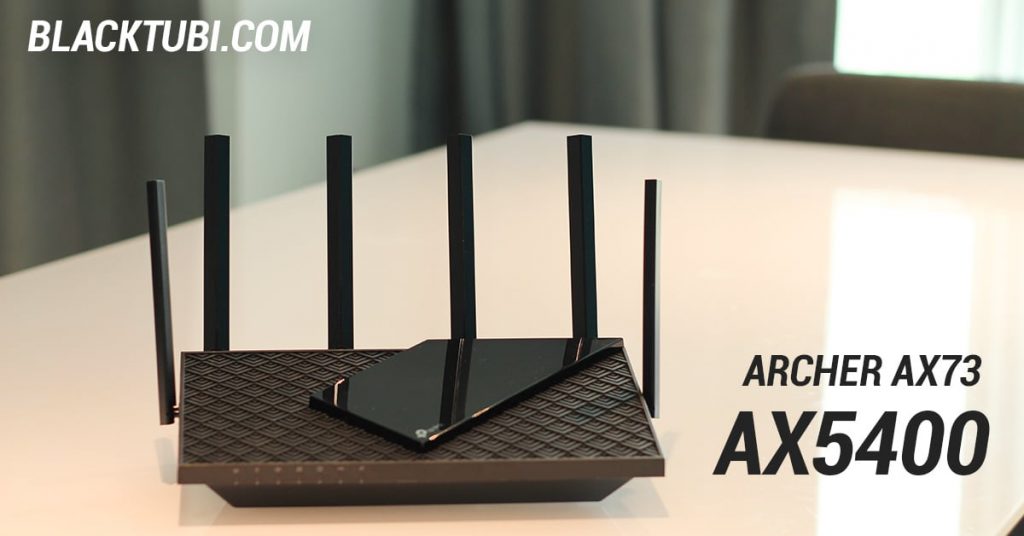
It’s 2021 and the pandemic is still here. This means we’re still working from home until things get better. Having a reliable and fast WiFi connection is crucial for work productivity. Thus, that brings us to the new TP-Link Archer AX73, a high-performance AX5400 wireless router now available in Malaysia.
The Archer AX73 is a high-performance WiFi 6 router. It can support total WiFi link speed up to 5400Mbps with dual-band configuration. In fact, the router supported the 160Mhz mode which means the 5Ghz WiFi network can get really fast if you have a 160Mhz supported WiFi adapter.
What’s so good about the Archer AX73 is the price. It is available for sale at just RM399 in Malaysia with a 3 years one-to-one exchange hardware warranty and after sales support from TP-Link Malaysia.
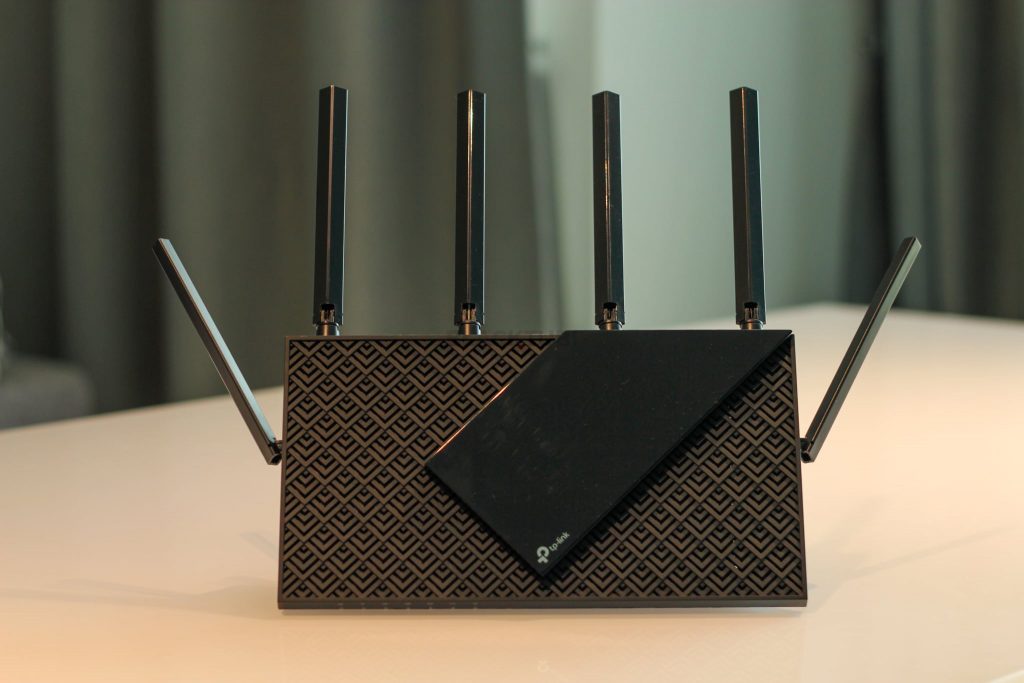
Table of Contents
The first thing that you’ll notice from the Archer AX73 is the 6 antennas. These antennas are real and not just for show. We’ve taken apart router and identified that 4 antennas are used for the 5Ghz network and 2 antennas are used for the 2.4Ghz network.
The reason why there are 6 antennas is because the Archer AX73 uses an individual antenna for each transmit channel rather than combining both the 2.4Ghz and 5Ghz into a single antenna. Rather than using a dual-band antenna, each antennas on the router are optimized for their desired frequency, resulting in better performance without compromises.
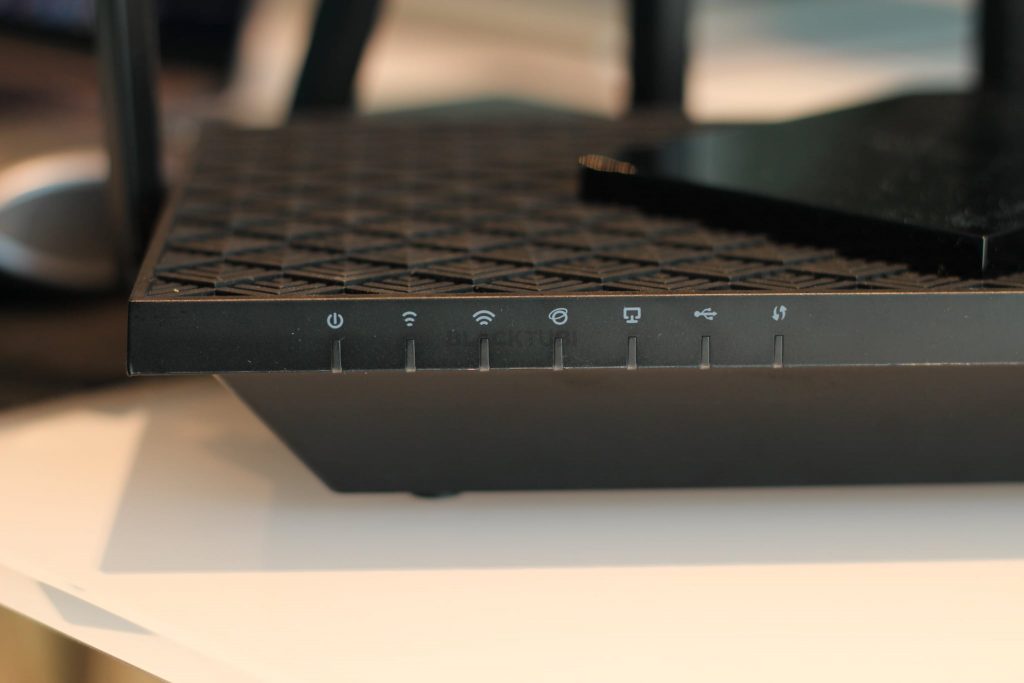
The Archer AX73 also runs really cool and stable in our test. It’s because TP-Link used a much larger heatsink and added more ventilation. This is why the Archer AX73 is so big and heavy! In fact, it barely heats up even on prolonged stress test and certainly much cooler than the infamous Archer AX50.
Hardware and Specs
| Wireless 2.4Ghz | Wi-Fi 6 up to 574Mbps (40Mhz 2X2) |
| Wireless 5Ghz | Wi-Fi 6 up to 4804Mbps (160Mhz 4X4) |
| WiFi Features | OFDMA, MU-MIMO, Beamforming, WPA3, OneMesh |
| CPU | Broadcom BCM6750 1.5Ghz Triple-Core |
| Ethernet Ports | 1x Gigabit WAN port + 4x Gigabit LAN port |
| USB | 1x USB 3.0 port |
The Archer AX73 is powered by a fast Broadcom 1.5Ghz Triple-Core CPU and comes with 512MB RAM. TP-Link says this router can actually support up to 200 devices connected simultaneously. While I don’t have 200 devices to test, the router do work realiably in my home with close to 50 devices connected to it.
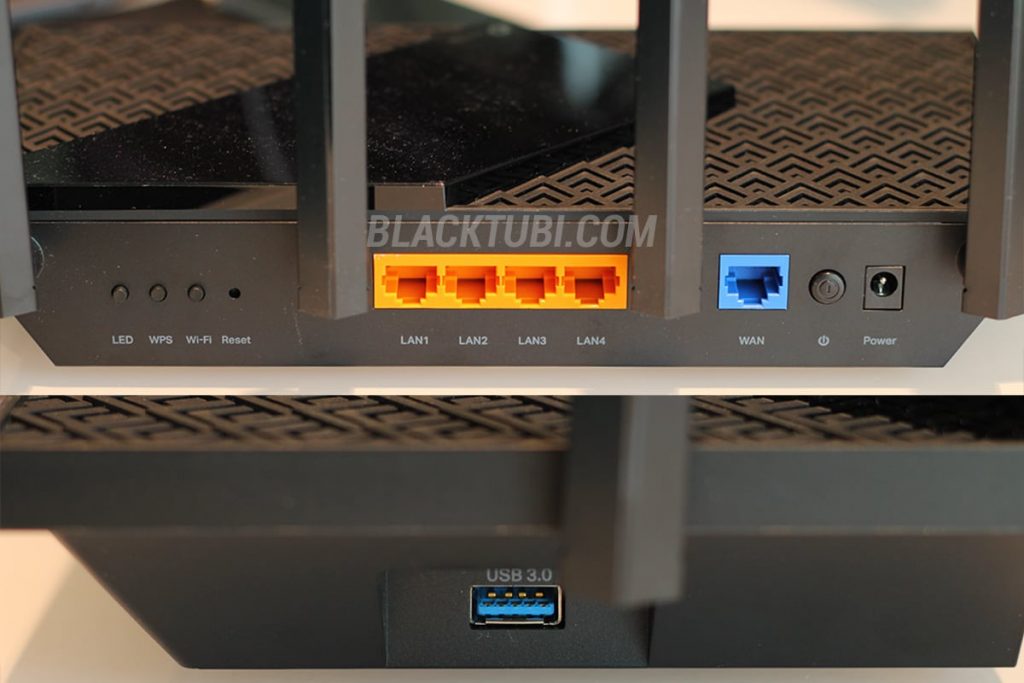
Connectivity wise, the router comes with 4 Gigabit Ethernet LAN ports and a single Gigabit Ethernet WAN port. It also comes with a USB 3.0 port which can be used for file sharing and printer sharing to devices connected to the wireless router. The LED status indicator on the router can be disabled if needed.
Unboxing Archer AX73
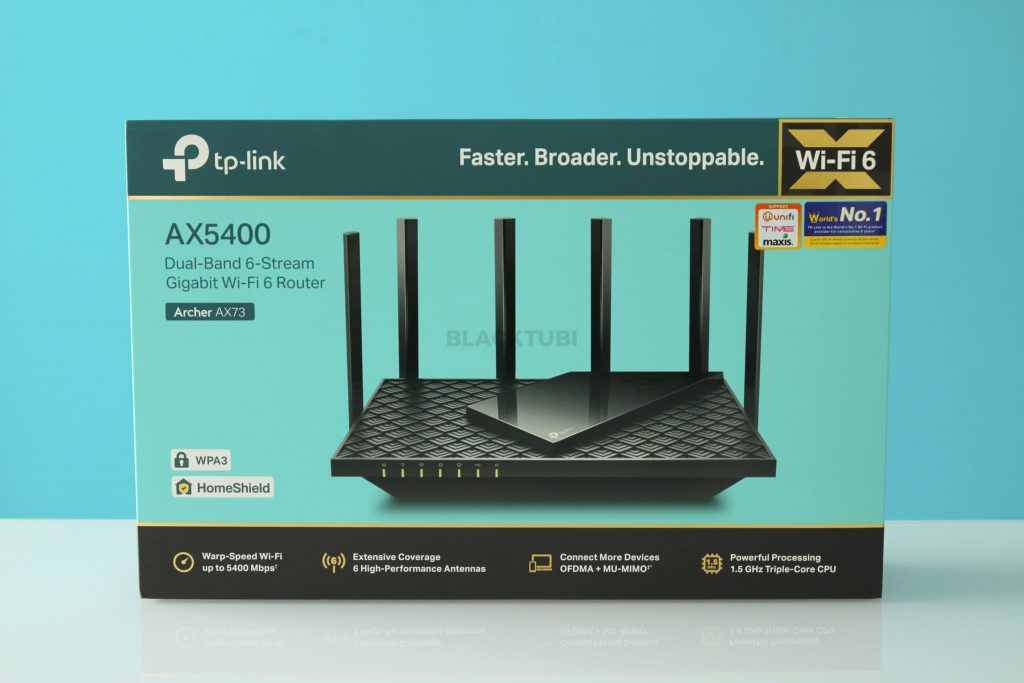
The box of Archer AX73 for Malaysia market comes labeled with support for TM Unifi, Maxis Fibre and TIME Fibre.
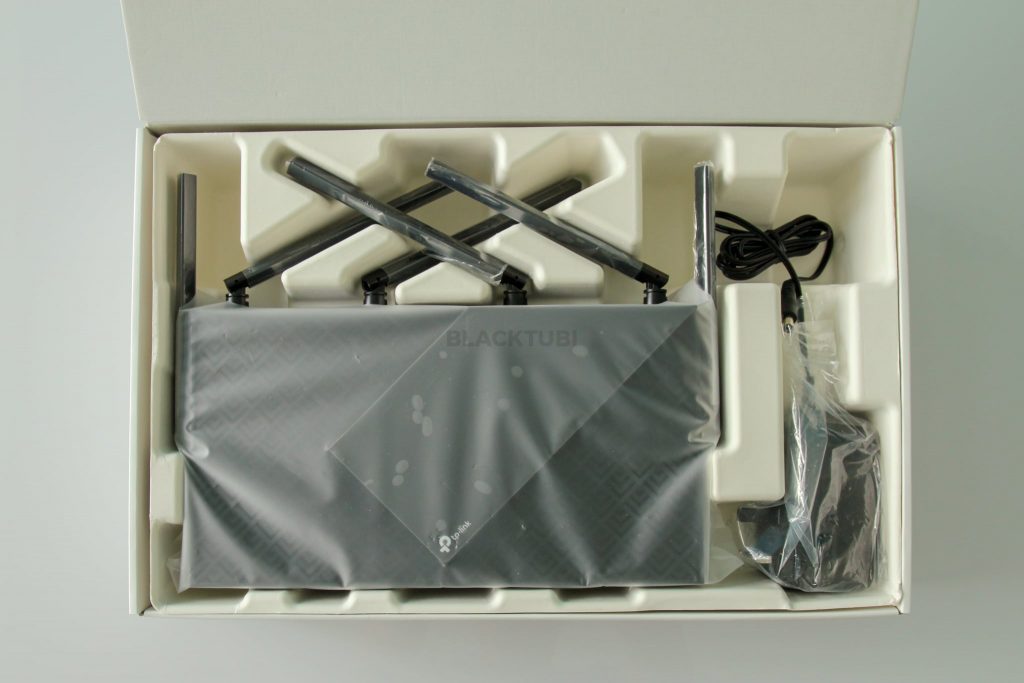
Each antenna on router and accessories are individually wrapped. The cardboard box also provide sufficient protection during shipping. It comes with a CAT5E Gigabit Ethernet LAN cable and a 12V power adapter.
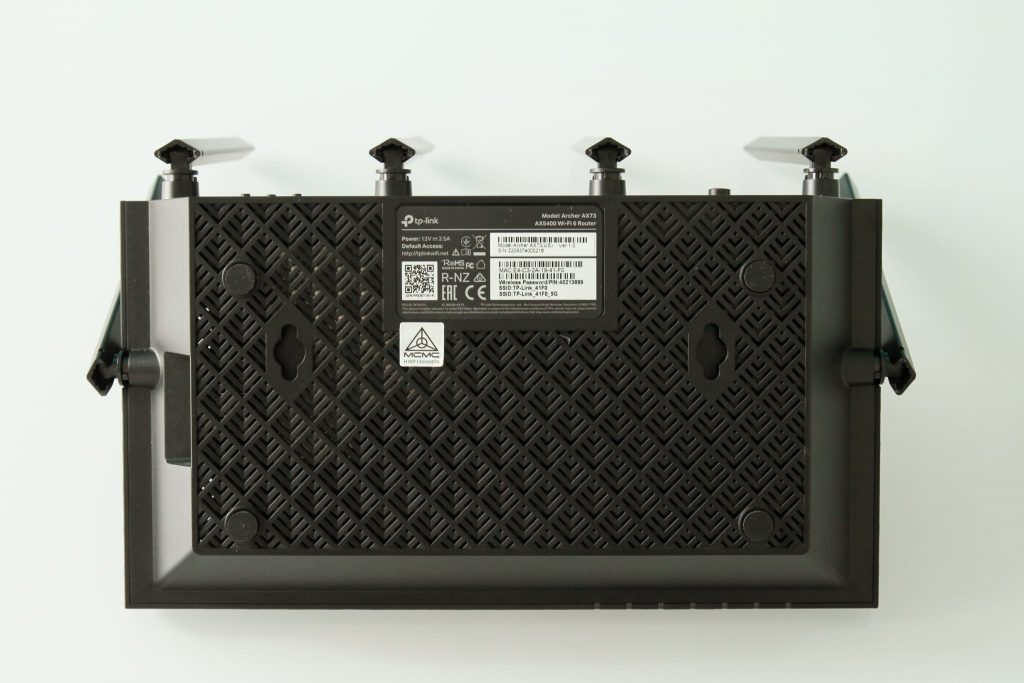
It is possible to wall-mount the wireless router with 2 mounting holes behind the product. The default WiFi name and password is also labeled on the back of the router. Similar to the top, the entire bottom of the product is full of ventilation holes for enhanced cooling performance.
Quick Teardown
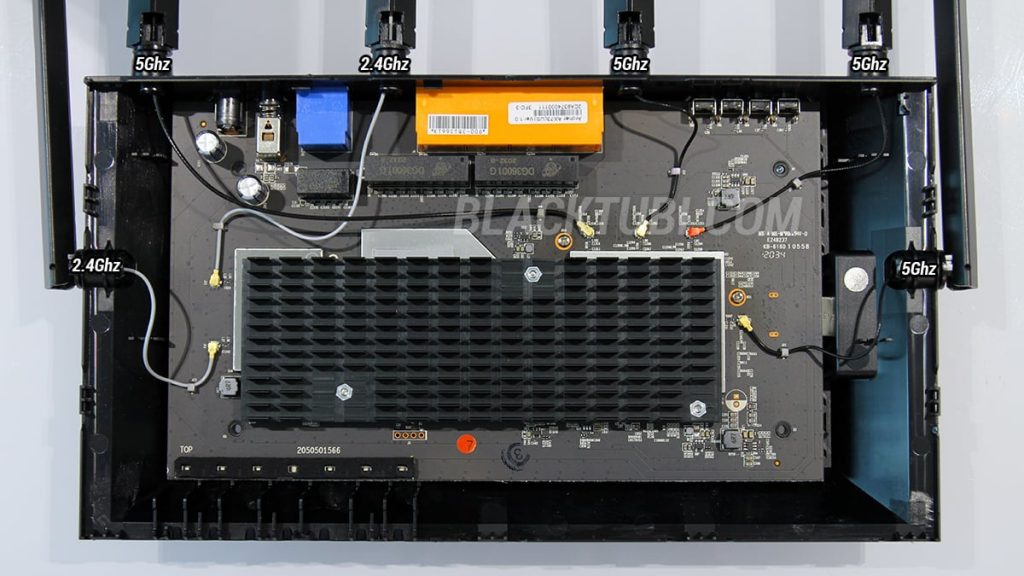
I also did a simple teardown for the Archer AX73. Since I am not a hardware enginee, I won’t comment much about this. WiFi related components are shielded and there’s a decent sized heatsink to cool down the router. This explains why this router barely heats up.
Wi-Fi Performance
With the beefy specifications, let’s see if that actually transfer into actual performance in our benchmark test. I will be using a laptop with the Intel AX200 wireless adapter and an iPhone to test the 5Ghz Wi-Fi 6 performance of TP-Link Archer AX73. I will be skipping the 2.4Ghz result as it is probably irrelevant these days given how congested is the 2.4Ghz channel.
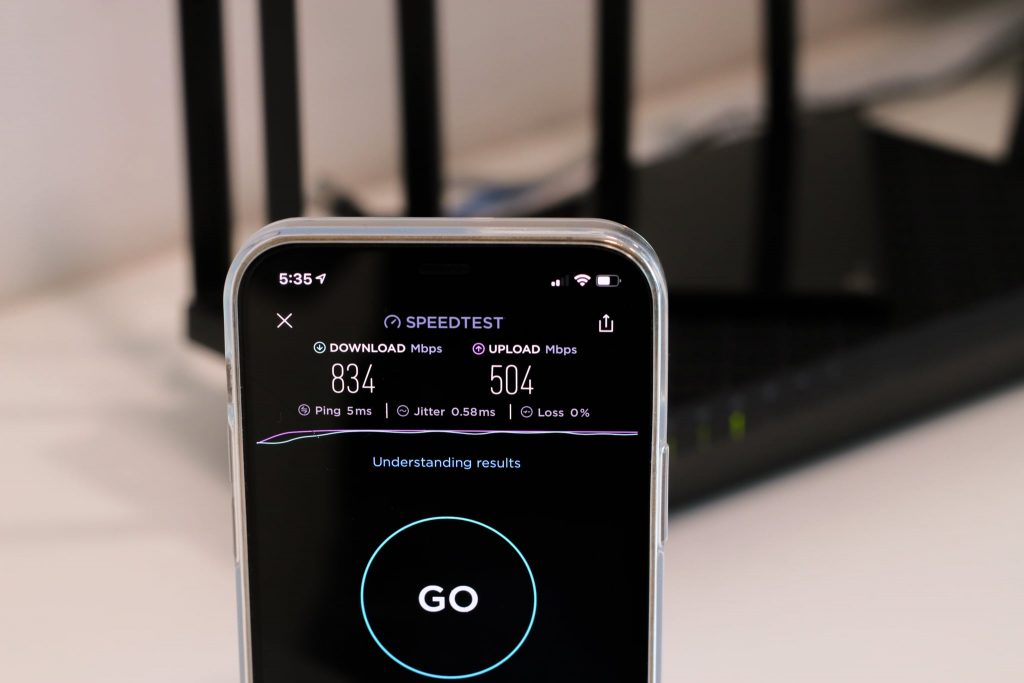
At short distance to the router, my iPhone can achieve over 800Mbps on the 5Ghz Wi-Fi network. This is not surprising considering most Wi-Fi 6 routers, even the budget models like Archer AX10 can deliver such performance. What we really want to know is the long range signal coverage and performance.
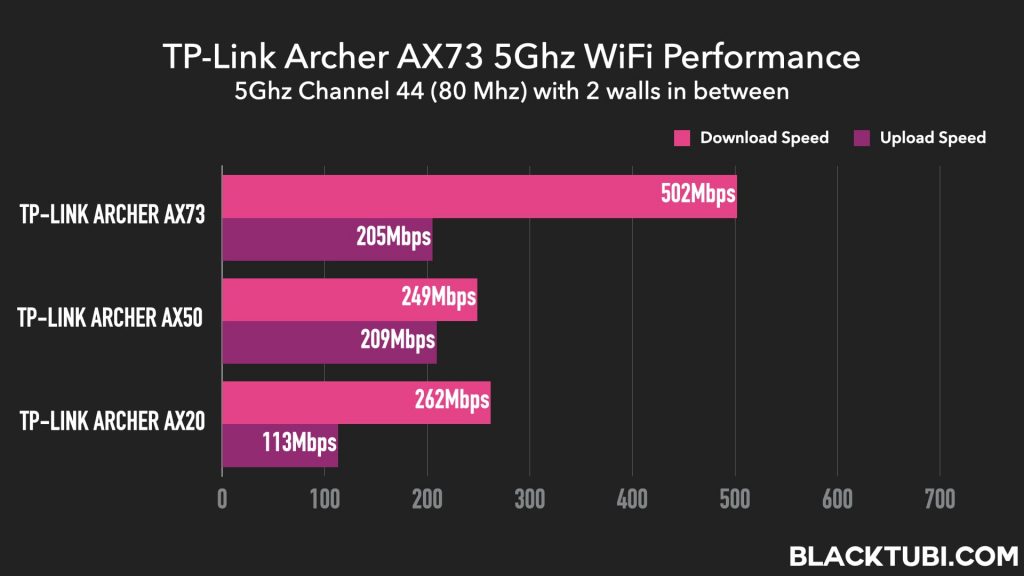
The 5Ghz signal on the Archer AX73 is really strong! The 5Ghz coverage and performance is faster and stronger than every single AX3000 wireless router that we’ve tested on this site. The performance is also stable and consistently replicable througout our review.
Security wise, it can support the latest WPA3 security right out of the box. However, I do not recommend using WPA3 as older WiFi devices may face compatibility issues. Considering a router last many years, you can consider enabling it few more years in the future as older devices are phased out from your home.
Firmware and Features
TP-Link maintain their philosophy of not overly bloating the firmware with features and I think it works here. Reliability is the keyword here as I find the Archer AX73 firmware is very well optimized. During my test, I do not face any issues with the router. The firmware always responded fast consistently.
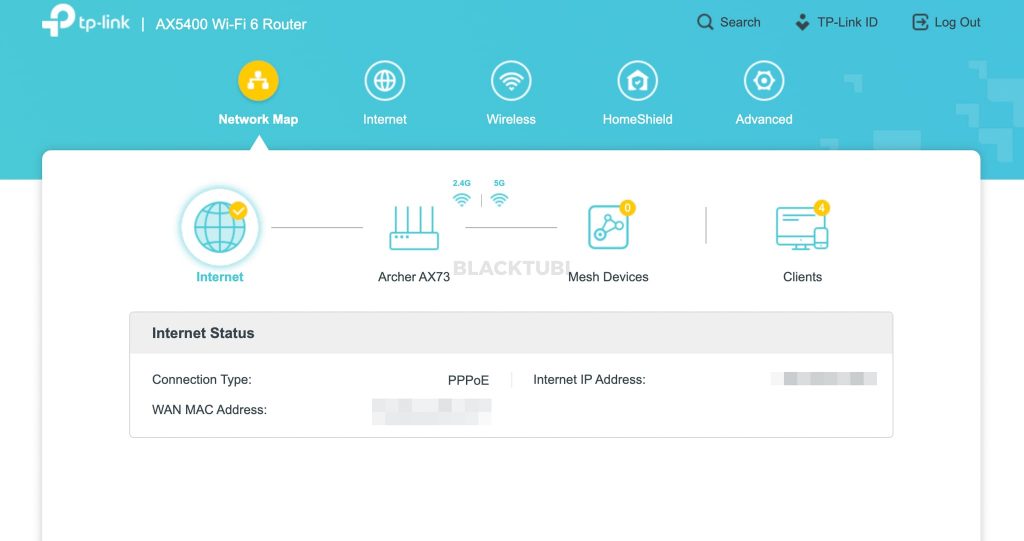
The web interface is simple to operate and certainly very easy to setup the router. It can support TM Unifi, Maxis Fibre and all ISPs in Malaysia. For most users, it will involve connecting the router to the modem and use the setup wizard on the interface. The VLAN profile must be selected for TM Unifi or Maxis Fibre users in Malaysia.
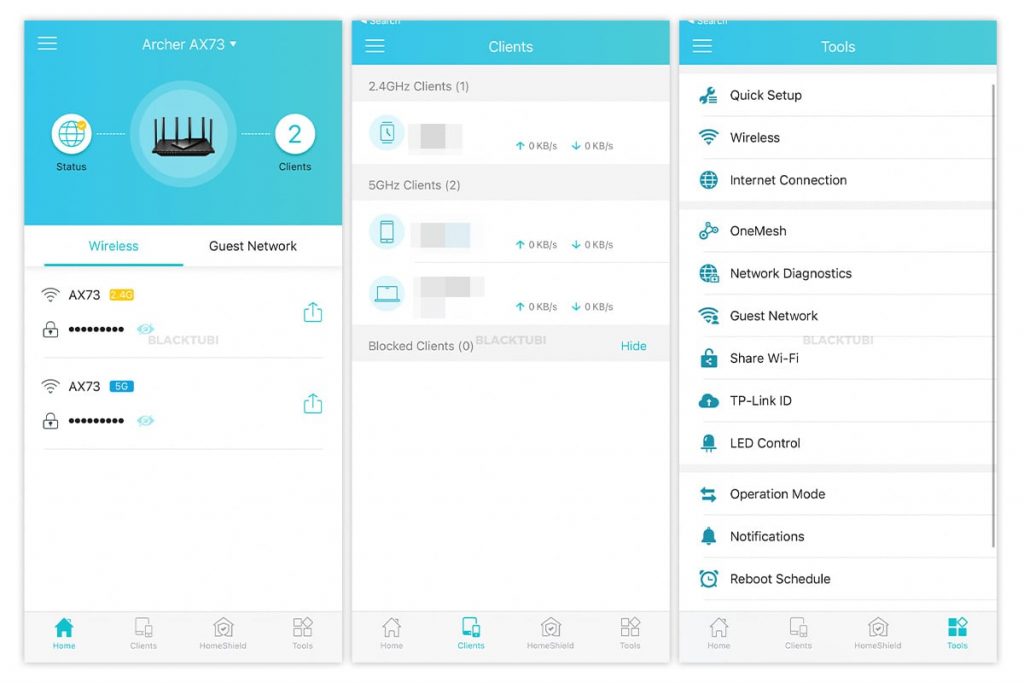
TP-Link Tether app offers a quick overview of your home network condition such as connected devices and network speed. The app is well designed and really responsive in our test. It is securely linked to TP-Link cloud and authenticated with your personal TP-Link account. TP-Link HomeShield security feature is only accessible on the app as well.
TP-Link HomeShield Security
TP-Link HomeShield is their new commercial grade firewall replacing the previous HomeCare feature. It can protect your devices from accessing a malicious website containing a virus or malware with an advanced antivirus firewall. This feature is now powered by Avira Antivirus database.
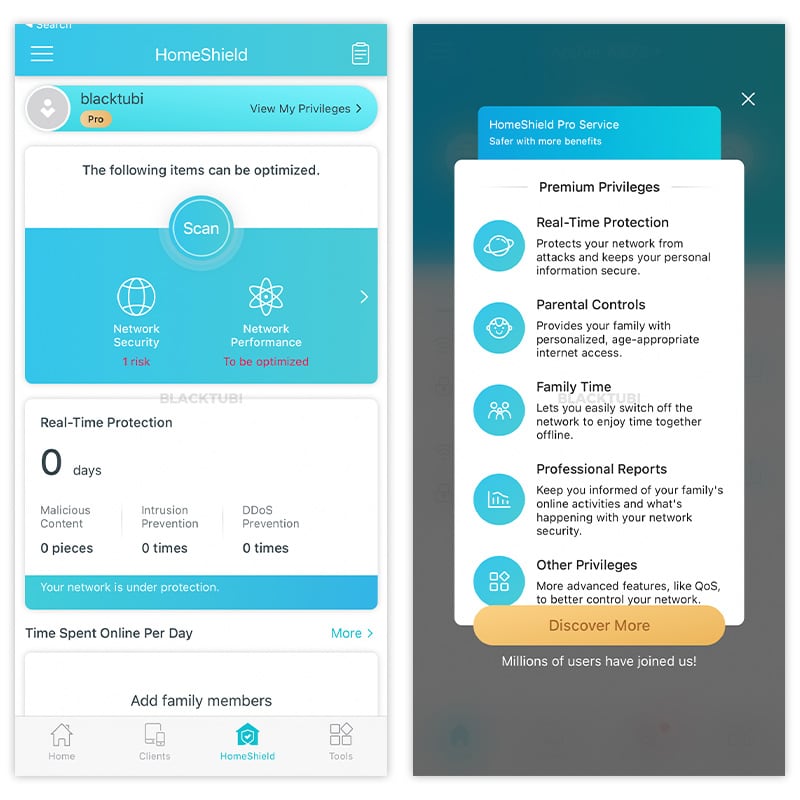
It also added protection for smart home and IoT devices. Considering these devices rarely receive firmware updates, having extra protection is certainly helpful. TP-Link claims it can protect an insecure device from being used as a loophole to launch attacks on your home network. We have no way of verifying these claims.
HomeShield Parental Control
TP-Link new HomeShield parental control is also much smarter than before. It can perform content filtering by category and usage time limitation. The categories are more comprehensive covering more websites than before. Based on our testing on some known sites, it is certainly more effective than HomeCare and other similar systems that we have tested on other brands.
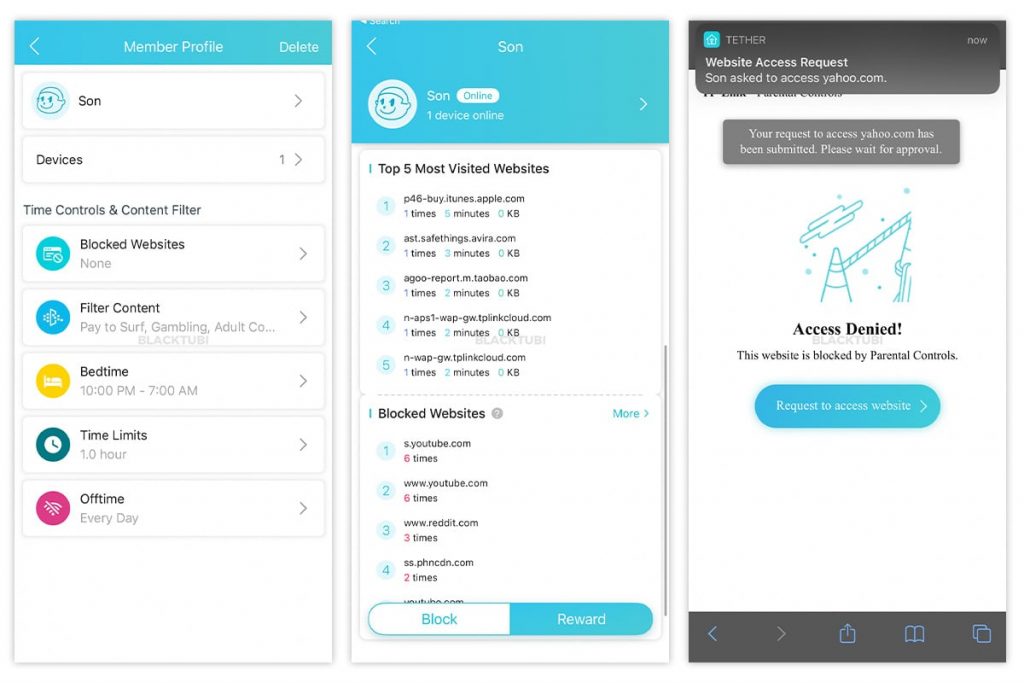
What’s so great about the new parental control is the ability to display usage charts and web history. It will show the top browsed website and attempts to access a blocked website by each user. If a page is blocked by the parental control feature, the user can request for access in which the admin can approve it via the TP-Link Tether app.
However, the upgraded HomeShield feature is not fully free. The Free tier only comes with the basic firewall without the advanced malicious content filtering feature. It also does not provide the comprehensive reporting of the parental control feature. More details available on TP-Link website here.
TP-Link HomeShield feature is a really robust parental control. While TP-Link provide a 30 days free trial of the Pro tier, it will cost RM24.90 per month after the trial has ended. I am fine with a subscription based business model but I find the price is too much.
OneMesh Capability
For those staying in a bigger home, it’s possible to link the Archer AX73 with a OneMesh extender. The OneMesh extender will then work together with the Archer AX73 resulting in a stronger WiFi coverage with true mesh WiFi features like seamless roaming and band steering unlike a traditional WiFi extender.
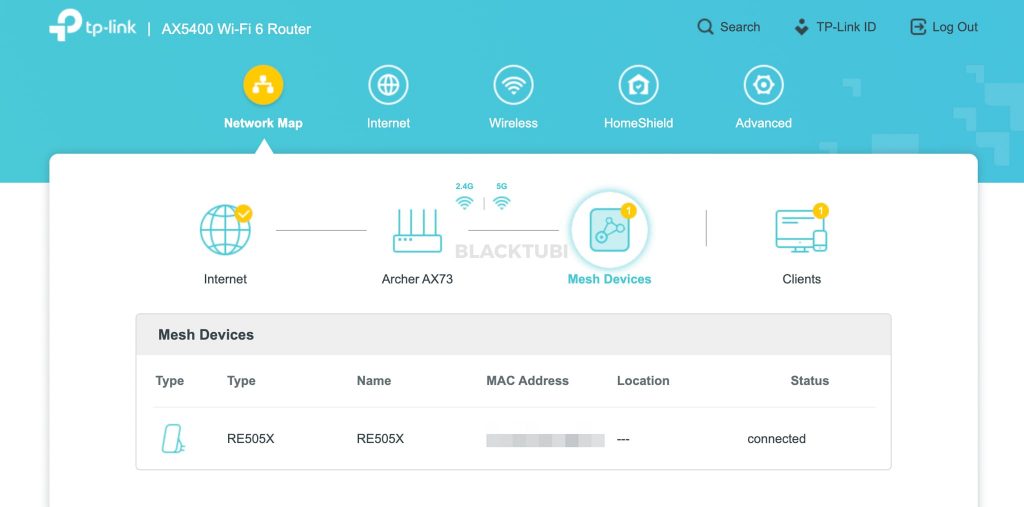
For the Archer AX73, I will only recommend linking it with a WiFi 6 OneMesh extender such as the RE505X and RE605X. Unfortunately, TP-Link does not allow router to router OneMesh currently. You also cannot link the Archer AX73 to a Deco Mesh WiFi system directly as they are based on a different technology.
Closing Thoughts
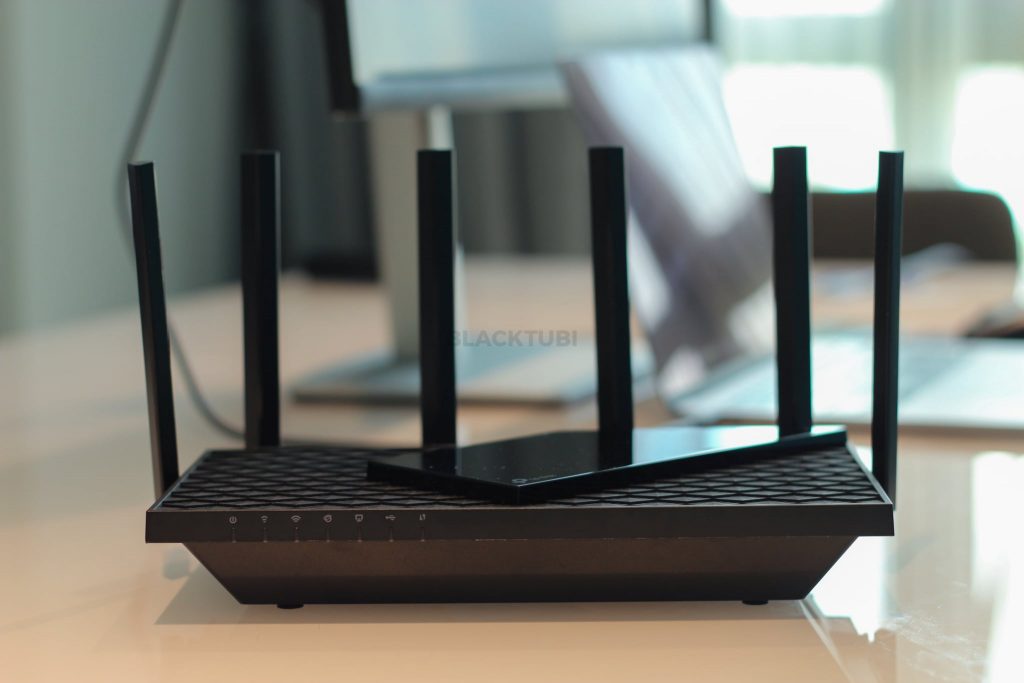
At RM399, the Archer AX73 offers really good performance even when comparing to some other routers that cost twice as much. It offers really good 5Ghz WiFi coverage and very fast WiFi speed on the 5Ghz channel with 160Mhz. Coupled with a fast 1.5Ghz Triple-Core CPU, it is a really good product from TP-Link.
TP-Link software is also smarter than before with a robust class-leading parental control feature. TP-Link is committed to provide more security to smart home and IoT devices with the new HomeSuite security suite. WPA3 security is also supported right out of the box.
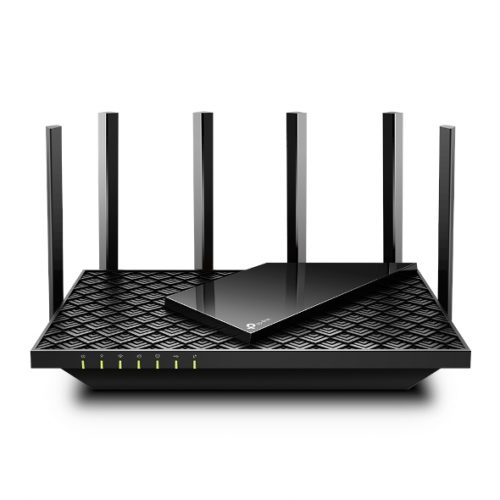
TP-Link Archer AX73
9.2
Tubi Rating
pros
- Premium performance at affordable price
- Robust HomeShield parental control solution
- Stable and reliable software
- Good security
CONS
- Advanced HomeShield features require a subscription
- Limited OneMesh support

Hi, im contemplating to switch from unifi to astro broadband and im currently using this router, how to configure it to astro broadband? thank you
Not really sure how to configure to Astro Fibre as I have not tried it.
Hi. Im currently only using 30mbps plan and looking for recommendation for a router with good wifi coverage for corner house 2 storey ~3000sqft. mainly want to cover all my wifi cctvs
WiFi CCTVs are really bandwidth intensive device despite their low price. Get a router with really good 2.4GHz performance. The Archer AX73 is a good choice.
Will the AX72 and 73 be any different for my case? Thinking that 100 bucks saved can go to a one mesh extender just in case.
Get the Archer AX72, their performance difference is very minimal.
Thanks for the input. One last question. AX72 + RE505X vs Deco M9 vs Deco X20.
which would be the best option? since they are all similarly priced.
This is a hard one but I might prefer the AX72 + RE505X. However, Deco do offer a much more seamless mesh experience with the fast roaming capabolity. Almost zero downtime as you walk around.
Thank you very much for your time. I’ve decided to go for the M9, as it was on offer RM549 for 2 packs and it has triband dedicated backhaul
Hi, do you have any recommendation setting to get maximum speed for unifi 800mbps using this ax73?
The stock setting is the best. Just make sure you use a WiFi 6 device as well to get the maximum possible speed. Wireless AC devices are typically limited to around 600Mbps.
Hi. I’m using 100mbps unifi plan. So in your opinion what should i get? Ax55 or ax73? Is ax73 is to much & overkill for me?
Just get the Archer AX73. It’s not overkill.
I see there is a newly releases AXE75 which looks the same but with wifi 6e and better processor etc. Would you recommend that instead?
I have not tested it yet. However, I think the Archer AX73 will still be a solid product as 6Ghz is not really that widespread yet.
Hi, thanks for the review. I need to replace my aging RT-AC55UHP, my question is, if I turn off wifi 6, does this router still have wider coverage than the old one? Can I bridge my old router to this? Thanks!
Yes, that’s because newer routers typically come with a stronger WiFi signal amplifier which benefit all devices.
My Tp Link Archer C9 is randomly loosing the 2.4 connection lately (10 years old). Other than that its been rock solid performer pared with RE450 (v1), Would the Ax73 be a good replacement (i imagine it will be faster) going to pair it with the 605x onemesh
Yup the Archer AX73 is a great product from TP-Link.
Still the best bang for bucks WiFi 6 router for max coverage and speed?
Probably. Don’t think there’s something more competitive in terms of value currently.
How would you compare the AX68U against it?
I have not tested the RT-AX68U but the performance offered by the Archer AX73 is on par with ASUS AX5400 router. So, I will imagine the Archer AX73 to perform better than ASUS RT-AX68U which is just a AX2700 grade router.
Thank you! Ordered it and eagerly awaiting to see how this performs. Thanks for getting back to me!
can I mesh Tp Link Ax73 OneMesh with Linksys E9450 EasyMesh ?
Not possible
you are doing very nice reviews, thanks for that. i have a 3 story house and the router will be in the middle, very central. currently i am testing the c80 and i get good coverage but with very decent speeds further away from the router dropping to about 10 mbps from 200 mbps on 2.4 ghz next to the router. I have 1000 mbps going to the router. I am thinking about getting the ax20 or ax73. Could you guess which of the two routers would be enough to get better coverage and speeds around 40 mbps further away… Read more »
I would suggest the Archer AX73 and use 5Ghz whenever possible. 2.4Ghz really isn’t that fast with all the interference happening on this band.
thanks for the reply,
yes i am doing this smart feature where it changes between 5 and 2.4 but i just get 2.4 ghz far away so that was for comparing. the question is, does the ax20 improve the wifi range enough compared to the c80, or is it better to go for the ax73 when i do not really need the extra speed?
thank you
I think the signal strength of the Archer AX20 isn’t that much better compared to the Archer C80. However, the Archer AX20 is much faster due to WiFi 6. The Archer AX73 signal strength is one of the best in the class.
I currently have the D-Link DIR-882 AC2600 router which I’ve been using since the past four years.
I have a 300 Mbps internet connection in a 1700 Sq ft home with around 6 devices connected to Wi-Fi always.
I’ve installed the router centrally, and am able to get speeds up to 290 Mbps in all parts of my home except the far reaching ones where the speed goes down to 50 Mbps.
Could you please tell me the improvements I will get if I buy the Archer AX73?
Since you are already maxing out the speed of your Internet connection. The major improvement would be the speed when you’re further from the router.
Hi, did someone measure the power consumption of the AX73?
It comes with a 12V 2.5A power adapter so it will consume 30W at most.
Yes, that’s clear.
But it won’t consume 30W in idle or in typical workload mode.
Routers may vary somewhere between 5W – 20W.
So the average power consumption would be very interesting to me.